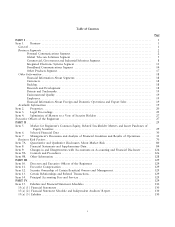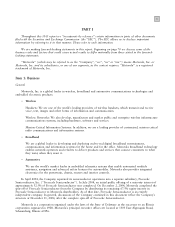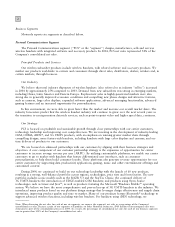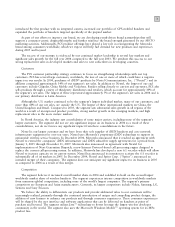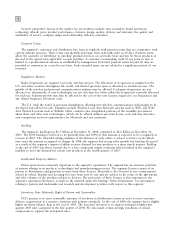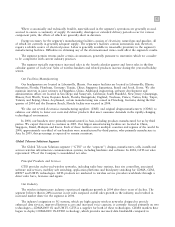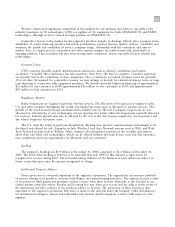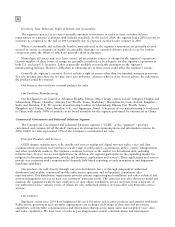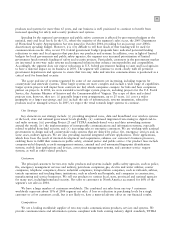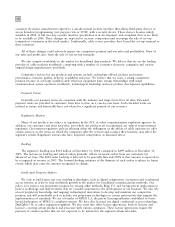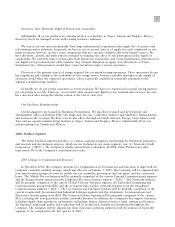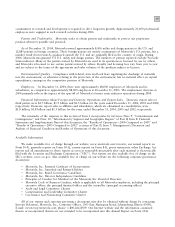Motorola 2004 Annual Report Download - page 18
Download and view the complete annual report
Please find page 18 of the 2004 Motorola annual report below. You can navigate through the pages in the report by either clicking on the pages listed below, or by using the keyword search tool below to find specific information within the annual report.
10
and Project 25. We experience widespread, intense competition from numerous competitors ranging from some of
the world's largest diversiÑed companies to foreign, state-owned telecommunications companies to many small,
specialized Ñrms. Many competitors have their principal manufacturing operations located outside the U.S., which
may serve to reduce their manufacturing costs and enhance their brand recognition in their locale. Major
competitors include: M/A-Com (Tyco), Nokia, Kenwood, E.F. Johnson, EADS Telecommunications and large
system integrators.
We may also act as a subcontractor to large system integrators based on a number of competitive factors
and customer requirements. As demand for fully-integrated voice, data and broadband over wireless systems
at the local, state and national government levels continues, we may face additional competition from public
telecommunications carriers.
Competitive factors for our products and systems include: price; technology oÅered and standards compliance;
product features, performance, quality, availability, delivery and support; and the quality and availability of support
services and systems engineering, with no one factor being dominant. An additional factor is the availability of
vendor Ñnancing, as customers continue to look to equipment vendors as an additional source of Ñnancing.
Payment Terms
Payment terms vary worldwide. Generally, contract payment terms range from net 30 to 60 days. As required
for competitive reasons, we may provide or arrange for long-term Ñnancing in connection with equipment
purchases. Financing may cover all or a portion of the purchase price.
Regulatory Matters
Users of two-way radio communications are regulated by a variety of governmental and other regulatory
agencies throughout the world. In the U.S., users of two-way radios are licensed by the FCC, which has broad
authority to make rules and regulations and prescribe restrictions and conditions to carry out the provisions of the
Communications Act of 1934. Regulatory agencies in other countries have similar types of authority. Consequently,
the business and results of this segment could be aÅected by the rules and regulations adopted by the FCC or
regulatory agencies in other countries from time to time. Motorola has developed products using trunking and data
communications technologies to enhance spectral eÇciencies. The growth and results of the two-way radio
communications industry may be aÅected by the regulations of the FCC or other regulatory agencies relating to
access to allocated frequencies for land mobile communications users, especially in urban areas where such
frequencies are heavily used.
The U.S. leads the world in spectrum deregulation, allowing new wireless communications technologies to be
developed and oÅered for sale. Examples include Wireless Local Area Network systems such as WiFi, and Wide
Area Network systems such as WiMax. Other countries also deregulated portions of the available spectrum to
allow these and other technologies, which can be oÅered without spectrum license costs and may introduce new
competition and new opportunities for Motorola and our customers.
On February 7, 2005, Nextel Communications agreed to a plan by federal regulators designed to address
interference from Nextel cellular phones with hundreds of public safety communications systems in the U.S.
According to the FCC, the agreement should dramatically reduce the likelihood of interference. Nextel will be
required to fund certain costs necessary to relocate those impacted users into the 800MHz spectrum. CGISS will
continue to work with our customers that are impacted by this plan and expects that this will have an overall
positive impact on the CGISS business over the next several years. However, the impact in the short term is
uncertain and yet to be quantiÑed, as all of the details of the plan are not Ñnalized.
Backlog
The segment's backlog was $2.1 billion at December 31, 2004, compared to $1.7 billion as of December 31,
2003. The 2004 backlog amount is believed to be generally Ñrm, and approximately 66% of that amount is
expected to be recognized as revenue during 2005. This forward-looking estimate of the Ñrmness of such orders is
subject to future events that may cause the amount recognized to change.


